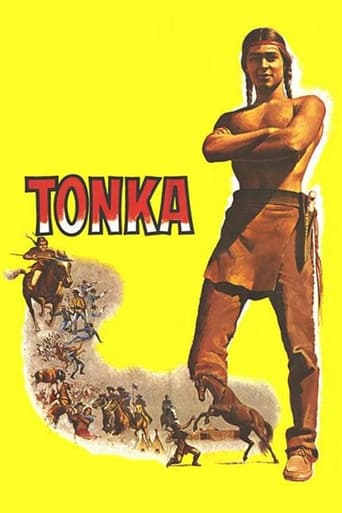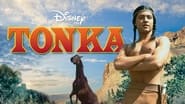melanivp
This movie, followed by a young reader's book two years later, started me on a study of the Battle of the Little Bighorn that has now lasted for over 50 years. Before watching it this evening, I had not seen the movie since it was released in theaters in 1958. I was pleasantly surprised to find some accurate historical details stuck into the fictional story, such as a bullet hitting Keogh in the knee and going on into Comanche--they clearly did some research, since that is an odd detail most people wouldn't know. The terrain at the battle looked very much like reality, as well. The Indians were another matter--I could swear I saw the stitching down the center of Sal Mineo's wig in an early close-up--but it wasn't bad for 1958, and the use of the Indians as central characters was both good and unusual.They also got the names of Custer's horses right, but for some reason called Keogh's other horse Pokey. It was actually Paddy. And as for Tonka Wakan--it is my understanding that that is roughly equivalent to naming your horse Jesus Christ. It may translate to "The Great One," but I believe it is usually used to refer to the Great Spirit.The characterization of Custer as a nasty, Indian-hating bad guy is totally not true. Custer actually liked Indians--it was simply his job to be at war with them, just as he had previously been at war with his West Point classmates who had joined the Confederacy. I am currently reading a very fine book on the Cheyenne War of 1864-69, and it is clear that there was a lot of killing and nastiness on both sides. By the time of Custer's demise, many tribal groups had surrendered and gone to live on reservations--but not Sitting Bull or Crazy Horse. They probably would have preferred to be left alone by white people, but the discovery of gold in the sacred Black Hills had made that impossible. So they had one final victory before it was all over, and that is the story told in this movie.Sitting Bull did have a nephew named White Bull, and other characters, such as General Terry, Lt. Nowlan, and Trooper Korn were also real. To the best of my knowledge, Yellow Bull was fictional, and I am not sure the representation of Lakota tribal culture was very accurate. The horse-breaking methods shown were common to cowboys, but not Indians--gentle training was more the norm.The details of other errors are too numerous to go into--the bit Keogh describes as "simple" seems to me to be a curb, rather than a snaffle; the uniforms are not right; the Indian clothing is weird--etc., etc., etc.But generally speaking, the movie is much more accurate than I remembered, and it is certainly a classic example of a Disney family movie. Thanks, Walt, for helping to change my life.
bkoganbing
Sal Mineo eschewed the urban areas which most of his films had him in for the Old West as he plays a young Sioux brave who captures and tames a wild horse he names Tonka. This is a fine film that still holds up well today and gave Mineo one of the best parts he ever had.Sal and his peer Rafael Campos are warriors in training and Sal after trying to capture a brown stallion he admires loses the rope and a bow and quiver of arrows and gets the riot act read him by Sitting Bull. Still he goes out and actually finds and tames Tonka. But a warrior cousin H.M. Wynant claims the horse by seniority. Mineo would rather see the horse anywhere else but with Wynant and he frees him.Through a chain of circumstances the horse gets captured and sold to the cavalry where he's renamed Comanche and he becomes the property of Captain Myles Keogh played by Philip Carey. And that is the background of the story of Mineo and the horse, the Battle of the Little Big Horn where the only survivor on the cavalry side was the horse Comanche.All the players including Custer and Keogh are real people and the Battle of the Little Big Horn is well staged by Disney Studios. And next to Mineo the most notable performance in the film is that of Britt Lomond as General George Armstrong Custer.If you are used to the image of Custer as portrayed by Errol Flynn in They Died With Their Boots On then what Britt Lomond did with the role will be a revelation. For those of you who think that Custer was glory hunting Indian hating fanatic than you will love to hate Britt Lomond. Lomond is best known as Captain Monasterio in the first episode of the Disney Zorro TV series. He was pretty hateful as Monasterio and just as hateful as Custer.Tonka is a nice coming age story told from the American Indian point of view. Kids will universally identify with both Mineo and Campos. Tonka is also one of Disney Studios best films of the Fifties and one of its best ever.
hpkenzo
A really amazing film to come from the Disney studio at a time ( 1958 ) when they were making tough films for family audiences. First viewed in 1965 aged 7 when my father hired the 16mm print for private home use to family and friends. I think he projected it twice and then the film remained in the memory for many years as an early favourite. Those were the days when you saw a film once or twice and there was no way of seeing it again until a reissue or TV. Having just seen the film again 43 years later, I have to say that it really is superb entertainment with a useful message about racial tolerance yet never needing to compromise it's swiftly told, exciting story. A passionate, memorable performance from a very fit, believably cast young Sal Mineo. Beautiful Technicolor photography from the great Loyal Griggs (Shane) and not forgetting the various horses used for the lead role of 'Tonka wakan - The Great One', of course several had to be used and one has to suspend disbelief occasionally as the animals don't always look similar but all in all Disney did a very commendable job. Top Direction from Lewis R.Foster with the battle at the Little Big Horn impressively staged. A very underrated film and long overdue for a DVD restoration, in fact some filmmakers do admire it as the whole story was recently reworked in animated form for a Spielberg production 'Spirit: Stallion of the Cimarron'.
melba-5
It,s one of those Disney family movies from the fifties, that gives you a good feeling, like many others from the same cataloging. Disney was outstanding in those days. Nostalgia, of course, but they don't make them like this anymore. Tonka, was one of the frontier movies that went a bit deeper into the Indian nation, and also portrayed Custer as the mean man he was. One of the first times from Hollywood actually. At the same time told the story of the sole survivor from The Battle of Little Big Horn in 1876. Excellent photography, and Sal Mineo's part as White Bull and his companionship with Tonka, was indeed heartwarming. Disney ought to put this out on DVD, with historical bonus etc. Jørn Back, Norway




